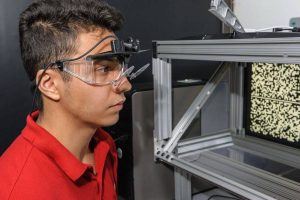Q1: What is convergence insufficiency (CI)?
A: Convergence insufficiency is a highly treatable binocular vision condition that affects near vision and eye muscle coordination.
Convergence insufficiency occurs when the eyes are unable to converge, or work together to focus on a near object. Children with CI must use additional effort to focus on reading, and other near vision tasks, in order to maintain focus for an extended period of time.
With CI, near vision tasks can become quite challenging— specifically affecting reading, learning, sports performance and even attention.
Q2: How common is CI?
A: Convergence insufficiency affects up to 1 in every 8 children, and approximately 13 percent of all school-aged students.
Unfortunately, many children with CI go undetected, and are incorrectly labeled as lazy, spacey, clumsy, anxious— or even misdiagnosed with ADHD, dyslexia, or mild autism.
Q3: What are the symptoms of CI?
A: The most common symptoms of CI include:
- Eyestrain
- Headaches or muscle tension
- Blurred or double vision
- Difficulty reading and concentrating
- Uses finger or ruler when reading
- Avoidance of close work
- Poor hand-eye coordination
- Anxiety
- Motion sickness/dizziness
Q4: Which tasks are challenging for a child with CI?
A: If your child has CI, he may struggle with:
- Homework
- Computer work
- Attention
- Reading
- Writing
- Comprehension
- Making crafts
Q5: How is CI diagnosed?
A: A diagnosis of CI will be made after evaluating the strength of your child’s visual skills, binocular vision, convergence, and focusing abilities.
A basic eye exam or school vision screening that only tests vision acuity using a 20/20 eye chart, cannot detect CI.
If you suspect your child has an eye condition, contact an eye doctor near you, who can diagnose and treat the condition.
SEE RELATED: Convergence Excess
Q6: Why is CI often undetected?
In most cases, CI often goes undetected in school age children because of an over-reliance on school vision screenings, and brief eye exams conducted by pediatricians.
This means that many children are not even evaluated for CI, and therefore cannot receive the help they need.
Instead, these children begin to avoid reading and other near vision tasks as much as possible, or use various strategies to combat their discomfort, such as using a ruler or finger while reading, or taking frequent breaks from an activity.
Q7: Can CI cause other vision problems?
A: Yes.
If untreated, CI can lead to more serious eye problems such as lazy eye (amblyopia) or an eye turn (strabismus).
These more serious problems can arise when CI is not treated properly, and a condition called suppression develops. Suppression of vision occurs when the brain actively “shuts off” one eye, causing loss of binocular (two-eyed) vision and depth perception.
Q8: What will happen if my child develops suppression?
A: With suppression, some or all of the following symptoms may present:
- Difficulty catching balls
- Avoidance of sports
- Clumsiness:
- Trips on uneven surfaces, stairs, and curbs
- Frequently spills or knocks over objects
- Bumps into doors, furniture and other stationary objects
- Sports accidents
- Poor eye contact
- Poor posture during near vision tasks
- Frequent head tilt
- Motion sickness and/or vertigo
Q9: What is the best treatment for CI?
A: Vision therapy is the most effective treatment for CI.
The Convergence Insufficiency Treatment Trial, conducted by the National Eye Institute, concluded that supervised vision therapy with home reinforcement is the most effective treatment for CI.
According to the research, 75 percent of all children that participated in the study achieved either full correction of their vision, or noticed significant improvements within 12 weeks.
In some cases, prism eyeglasses can be prescribed to decrease some of the symptoms associated with CI. However, prisms cannot cure the underlying problem causing CI— making vision therapy the most effective treatment method available.
Q10: What is vision therapy?
A: Vision therapy is a personalized program that involves a series of eye exercises that focus on training the eyes to work together— improving 3-D vision, depth perception, and clear binocular vision.
The goal of vision therapy is to strengthen the communication between the eyes and brain, to enable clear and comfortable vision at all times.
If your child is having difficulty in school, or is showing signs of a vision problem, schedule an exam with an eye doctor for a comprehensive evaluation of your child’s vision and visual skills.
LEARN MORE: Vision Therapy for Children
If your child is diagnosed with CI, a program of vision therapy can strengthen your child’s visual skills, and in doing so, strengthen the skills they need for success in school…and maybe even bring out their hidden passion for reading!










